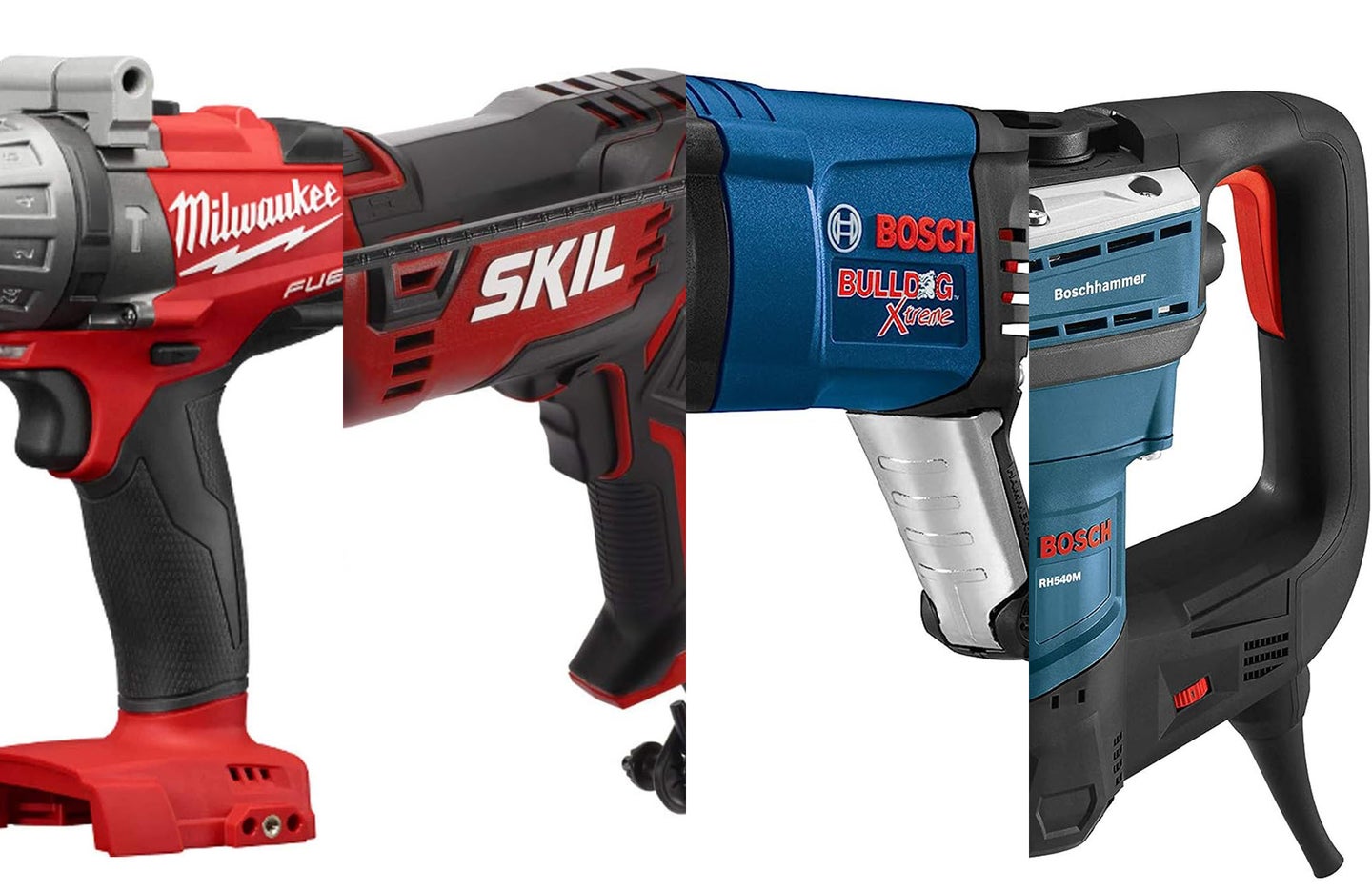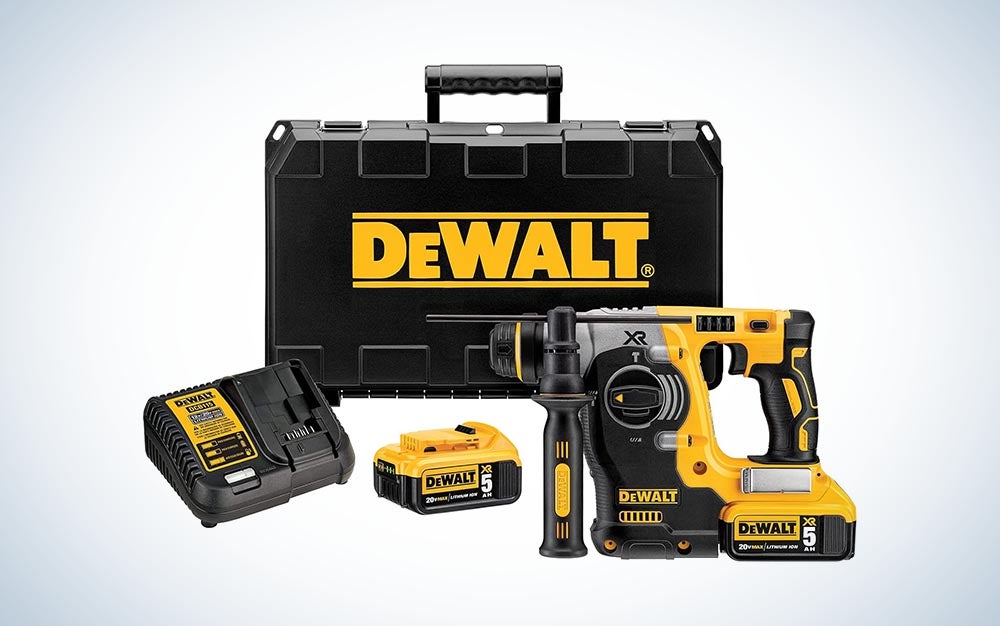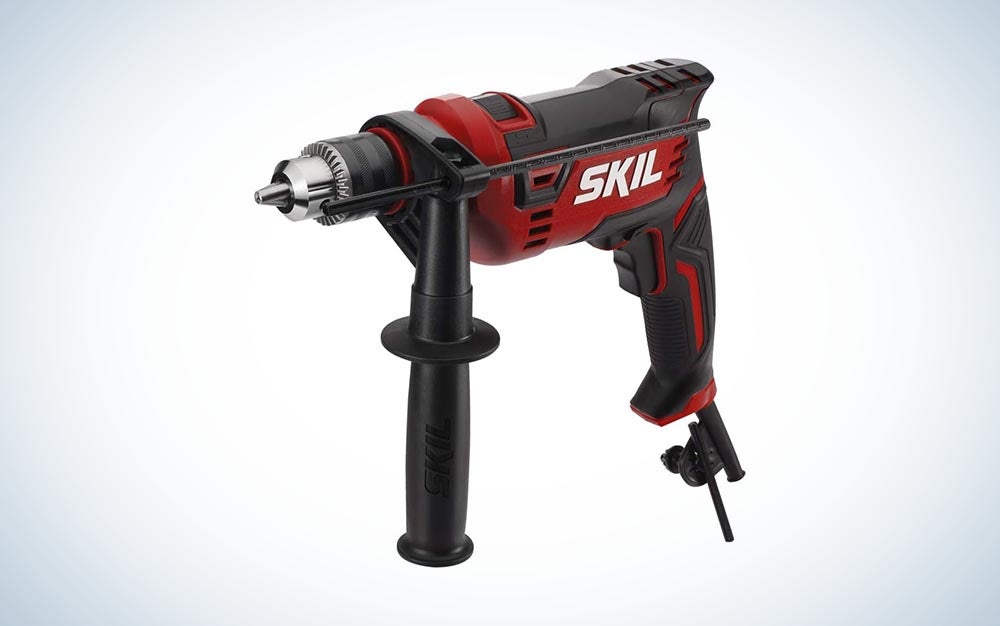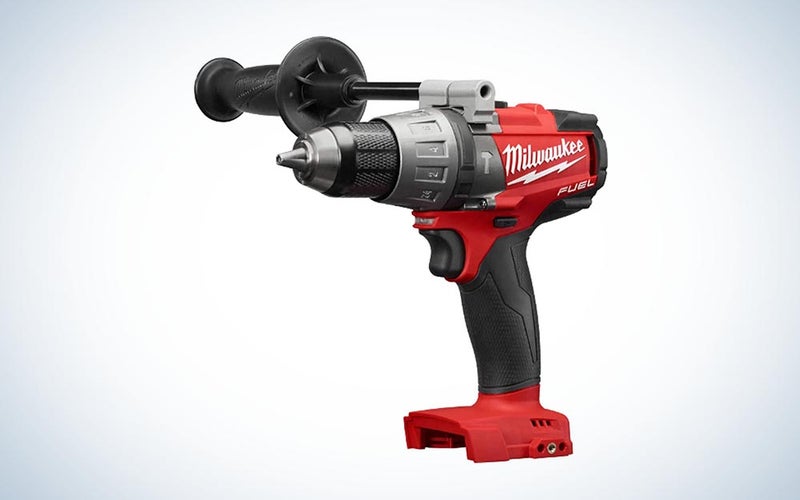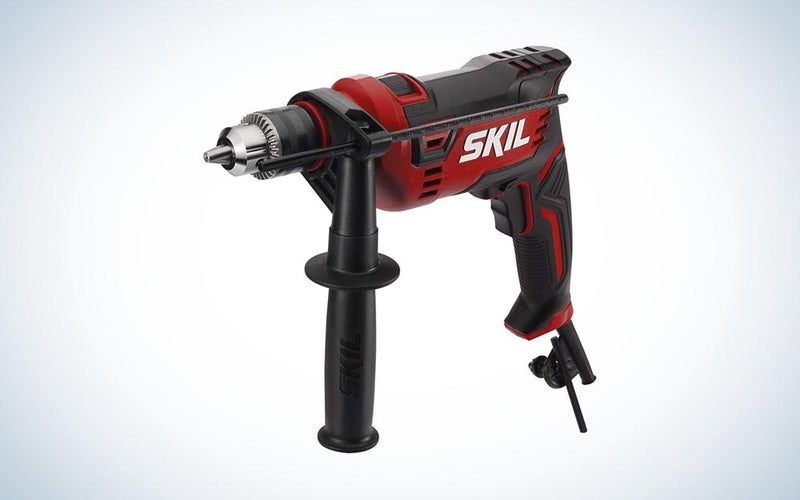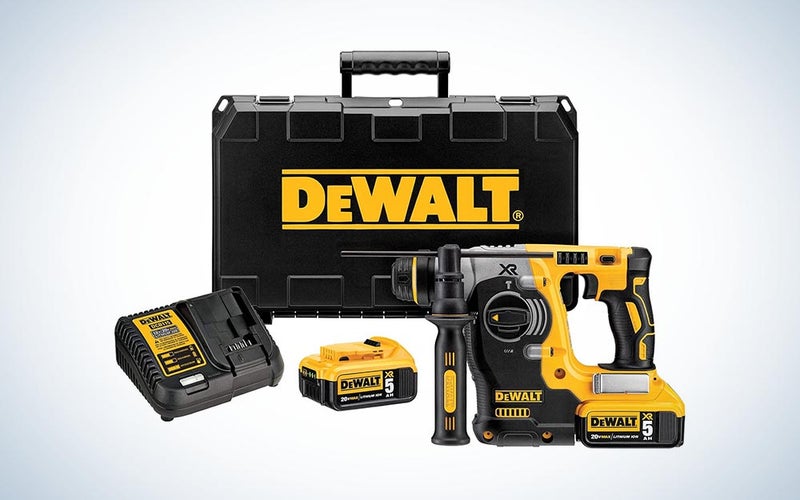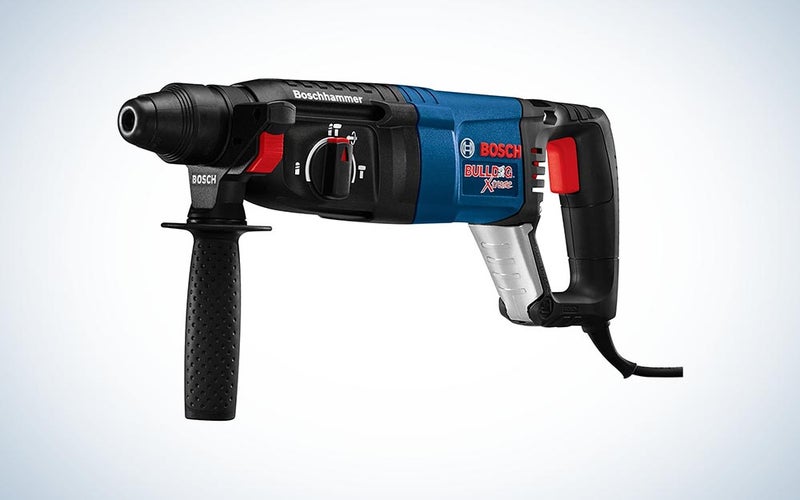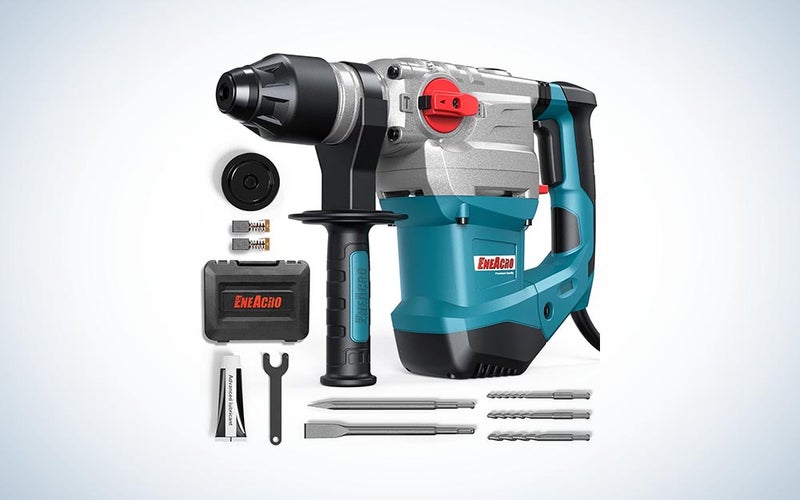We may earn revenue from the products available on this page and participate in affiliate programs. Learn more ›
Anyone who has ever tried hanging a shelf on a masonry wall will appreciate the benefits of a good hammer drill. They are a great addition to any DIY toolkit. At the entry-level, they are as easy to use as a standard drill driver but have the performance necessary to make light work of drilling holes in tough materials. For more challenging jobs we turn to rotary hammers. These powerful tools are not only capable of making holes large enough for pipework and electrical conduit but can also be fitted with chisels for light demolition duties. In this article, we explain all the key features to help you find the right tool for the task and offer recommendations for the best hammer drills for both DIY and professional users.
- Best overall: Milwaukee 2804-20 M18 FUEL 1/2 in. Hammer Drill
- Best budget: Skil 7.5-Amp 1/2-Inch Corded Hammer Drill
- Best splurge: DeWalt 20V MAX SDS Rotary Hammer Drill Kit
- Best corded: Bosch 11255VSR Bulldog Xtreme SDS-Plus Rotary Hammer
- Best DIY demolition: Eneacro 1-1/4 Inch SDS-Plus Rotary Hammer Drill
- Best heavy-duty: Bosch 1-9/16-Inch SDS-Max Combination Rotary Hammer
How we chose the best hammer drills
There are hundreds of electric drills available, and sometimes it can be difficult to tell what the important differences are. We wanted to focus on the distinct benefits of each type, while still offering as wide a choice as possible. I own a couple of these tools myself (not to mention many others), having remodeled two of our homes. So I know my way around saws and sanders and grinders, and as a team, we know drills and drivers. To supplement my experience, we researched all the leading manufacturers to ensure we were up-to-date with current technology.
Performance was obviously a key aspect while making selections, but we also looked at power source, ease of use, weight, and any useful extras. Brand reputation played a part because hammer drills are often used in harsh conditions, and reliability and durability are vital. Adding to that, we checked buyer feedback for a sense of how each one coped in real-world use.
The best hammer drills: Reviews & Recommendations
Each of the following is what we believe to be the best hammer drill currently available in its category and something we’d be proud to have in our storage shed. The wide range of models provided should mean there’s something for everyone, and the detailed descriptions will help potential buyers go beyond power drills and focus on the right tool for their needs.
Best overall: Milwaukee 2804-20 M18 FUEL 1/2 in. Hammer Drill
Milwaukee
Specs
- Power Source: Cordless 18V
- Chuck Size: 1/2”
- Maximum Speed: 2,000 rpm
- BPM: 32,000
Pros
- Claimed to be the most powerful hammer drill in its class
- Compact and lightweight making it easy to handle
- Redlink technology maintains performance under load and maximizes battery life
Cons
- Battery and charger cost extra
- Premium price tag does not include a case
Milwaukee is one of the world’s leading power tool brands with a reputation for high quality, and durability. Their compact hammer drill takes our top spot for its all-around appeal. It delivers the kind of performance and reliability that makes it a good investment for both keen amateurs and professionals.
Milwaukee claims the 2804-20 cordless hammer drill is the most powerful in its class. For standard drilling operations, it offers 2,000 rpm, and its 100 ft.lbs. of torque on tap are sufficient to drive substantial augers and hole saws when drilling wood. Switching to hammer action provides 32,000 BPM for efficient drilling in masonry and concrete.
The Powerstate brushless motor combines with Redlink battery management to maximize power delivery and run time between charges. It also has overload protection to prevent damage when the drill is pushed to its limits. A drill of this power needs a high-capacity battery, and a 5Ah unit is recommended. However, as is common with cordless tools, neither this nor the charger are included. If a spare is added it will more or less double the initial price. Given that this is already a premium tool we would have expected a case but one is not provided.
Best budget: Skil 7.5-Amp 1/2-Inch Corded Hammer Drill
Skil
Specs
- Power Source: Corded
- Chuck Size: 1/2”
- Maximum Speed: 3,000 rpm
- BPM: 48,000
Pros
- A good choice for the DIYer at a very competitive price
- Has soft grip handle and two-finger trigger for comfort
- Useful depth gauge included
Cons
- Keyed chuck is less convenient than keyless
- While normally reliable motor burnouts are not unknown
The Skill 7.5 amp corded hammer drill is an ideal choice for the occasional user. It isn’t big on features but has all the necessary functions, and is perfectly adequate for hanging pictures on a brick wall or putting up shelves in a cinder block garage.
The 1/2-inch chuck means it will take large drill bits, and with a maximum speed of 3,000 rpm, it will outperform most drill drivers. Skil gives an impact per minute (ipm) rate rather than the more common BPM but it means the same. In this case, it’s a surprising 48,000.
The two-finger trigger and soft-grip handle are nice touches that add a little comfort. A trigger lock means it doesn’t need to be held in all the time. There’s also a useful depth gauge. The power cord is only 6 feet which means you’re going to be using an extension cord most of the time, but that’s true of most corded power tools. It’s a shame they decided to save a few cents with a keyed chuck rather than keyless. Those keys are all too easy to misplace which can be very frustrating.
Best splurge: DeWalt 20V MAX SDS Rotary Hammer Drill Kit
DeWalt
Specs
- Power Source: Cordless 20V
- Chuck Size: 1” SDS Plus
- Maximum Speed: 1,050 rpm
- BPM: 4,600
Pros
- Powerful cordless drilling, hammer drilling, and chipping
- Vibration control for increased user comfort
- Includes two high-capacity 5Ah batteries, charger and case
Cons
- It’s hard to fault but it is a lot of money
- No drill or chisel bits included
The DeWalt SDS rotary hammer drill is the most impressive cordless drill we came across during our research. It’s what is often called a prosumer model, appealing to DIY enthusiasts taking on substantial remodeling jobs, and contractors looking for lightweight and versatility. This drill set has drill, hammer drill, and hammer-only functions.
It is fitted with a 1-inch SDS Max chuck and runs at a maximum speed of 1,050 rpm. BPM is 4,600, and each blow comes with an impact force of 2.1 joules (1.5 ft.lbs.). Heavy hammering like that causes a lot of vibration, which soon becomes tiring. DeWalt employ Shock Active Vibration Control to dramatically reduce user discomfort, and extend working time.
The DeWalt SDS rotary hammer comes with a charger and two high-capacity 5Ah batteries so there can always be a spare available to reduce downtime. Each has a useful 3-stage LED giving charge status. There’s a depth rod, and the whole kit comes in a durable plastic case. For professional users, the DeWalt SDS rotary hammer can be paired with DeWalt’s onboard extractor thus complying with OSHA Table 1 standards for protection against respirable crystalline silica.
Best corded: Bosch 11255VSR Bulldog Xtreme SDS-Plus Rotary Hammer
Bosch
Specs
- Power Source: Corded
- Chuck Size: 1” SDS Plus
- Maximum Speed: 1,300 rpm
- BPM: 5,800
Pros
- A robust tool at a competitive price from a market leader
- Ergonomic handle and modest weight aid working at all angles
- Automatic clutch helps prevent wrist injuries
Cons
- Requires periodic maintenance
- No vibration suppression
You can tell by the appearance that the Bosch Bulldog Xtreme is made for serious work. The slender design allows you to lean into the tool when necessary, applying maximum pressure. Not that much effort will usually be required. Performance figures are impressive for a tool in this price range with a maximum speed of 1,300 rpm, 5,800 BPM, and impact energy of 2.0 ft.lbs.
The variable trigger allows slow starting, reducing the chances of the drill bit wandering. It also allows accurate positioning when chiseling. The large ‘D’ handle has plenty of room for a gloved hand and includes a metal plate at the front that flips down to create a useful hanging hook. There’s a depth rod, and Bosch Pro-Guard dust extraction can be added for those who need to comply with OSHA regulations.
An automatic clutch is fitted to the SDS Plus chuck, which is a great safety feature. If the bit jams the drive is disconnected thus preventing wrist injury. There isn’t any vibration control so although the Bosch Bulldog Extreme is only 6.7 pounds it can get tiring after a while. As with all brush motors, the brushes will eventually wear, and need replacing though the job is fairly straightforward.
Best DIY demolition: Eneacro 1-1/4 Inch SDS-Plus Rotary Hammer Drill
Eneacro
Specs
- Power Source: Corded
- Chuck Size: 1-1/4” SDS Plus
- Maximum Speed: 820 rpm
- BPM: 4,200
Pros
- Kit includes drill and chisel bits, spare brushes, grease, wrench, and case
- Exhaust protects motor from excess heat
- Anti-vibration system and safety clutch
Cons
- It’s heavy
- Occasional breakdowns suggest inconsistent quality control
The Eneacro SDS Plus rotary hammer is remarkable both in terms of what you get for the money, and the performance it delivers. In addition to the drill itself the kit includes 3 drill bits, 2 chisel bits, grease, spare brushes for the motor, and a wrench. To keep everything organized, there’s a tough plastic case.
A top speed of 820 rpm isn’t as fast as some, but the 4,200 BPM is delivered with a powerful impact force of 5.5 ft.lbs. There’s an anti-vibration system and a soft grip handle for operator comfort. There’s also a safety clutch that disengages the drive if the bit jams to prevent injury. An exhaust helps stop the motor from overheating, and the base is designed to prevent dust from getting in. We’re a little surprised there isn’t a depth gauge, but it’s a minor gripe on an otherwise very good tool.
There’s really only one thing that prevents us from recommending the Eneacro rotary hammer for professional use, and that’s the weight. At 12.58 pounds it is heavy for a tool that is going to be used all day. DIYers can usually take a break, but contractors can’t afford to.
Best heavy-duty: Bosch 1-9/16-Inch SDS-Max Combination Rotary Hammer
Bosch
Specs
- Power Source: Corded
- Chuck Size: 1-9/16” SDS Max
- Maximum Speed: 340 rpm
- BPM: 2,750
Pros
- Variable speed dial for consistent control
- Vario-Lock mechanism provides optimum chisel angle
- Service minder brushes indicate when maintenance is required
Cons
- No drill-only option
- Heavy, and no vibration control
The Bosch SDS Max rotary hammer is a heavy-duty tool that, according to the manufacturer, is aimed at concrete contractors and professional remodelers. Its focus is underlined by the fact that there’s no standard drill function. It is either hammer drill or hammer-only.
Maximum speed is a relatively slow 340 rpm, but when you are driving very large drill bits control is more important. Most hammer drills offer variable speed triggers that demand you keep your fingers steady. The big Bosch has a stepped speed dial instead so concentration can stay at the business end. BPM is 2,750 delivered with a class-leading 6.1 ft.lbs. of impact energy.
In addition to mode selection the Bosch SDS Max rotary hammer has a Vario-Lock mechanism that allows chisel bits to be fixed in one of 12 positions so users have the optimum working angle without having to contort hands and arms. Service minder brushes give a clear visual indication of when they need to be changed, taking the guesswork out of a vital maintenance operation.
What to consider before buying a hammer drill
When detailing each of our best hammer drill picks, we’ve highlighted performance specifications and key features. In the following section we look at exactly what each of these means, and the impact they can have on your choice.
Types of hammer drill
The term ‘hammer drill’ can cover a varied range of tools, so they are usually divided into two groups: standard hammer drills, and rotary hammers.
Standard hammer drills are the first step up from an ordinary drill/driver adding a hammer action to the drill function so that in combination with a masonry bit they can drill holes in tough materials like brick, concrete, paving, and stone.
Rotary hammers usually have three functions: drill, hammer drill, and hammer only (some heavy-duty tools don’t offer a drill-only option). Rotary hammers accept much larger drill bits, and as a result, are capable of making much larger and deeper holes. When switched to the hammer-only function and fitted with chisel bits, they can be used to strip tile and undertake light demolition tasks.
Demolition hammers are heavy-duty tools that are sometimes confused with hammer drills but they have no drilling function at all, and so fall outside the scope of this article.
Chuck
There are two types of chuck used in these tools.
Standard hammer drills have a three-jaw chuck, the same as those found in drill/drivers. It is usually tightened by hand, though some use a key.
Rotary hammers use SDS chucks. SDS stands for Slotted Drive Shaft, a system that interlocks the drill or chisel bit with a spring-loaded collar on the tool to prevent them from slipping under heavy load. There are three shaft types: SDS, SDS Plus, and SDS Max. The first two have a 10mm shaft, but the slots are slightly different. SDS bits will usually fit SDS Plus drills, but not the other way around. SDS Max has an 18mm shaft and therefore can take larger diameter and longer drill bits.
Although it’s not a precise measure, generally speaking, the larger the chuck diameter, the more powerful the tool.
Performance
Rotational speed is an important factor in any kind of power drill. Whatever the material, a faster speed usually means the bit cuts more quickly. This is equally true of hammer drills whether the hammer action is engaged or not.
BPM stands for blows per minute and is the impact speed of the hammer action. A faster BMP might be seen as delivering more destructive force but the figure can be deceptive. Standard hammer drills often have very high BPM but the energy behind each impact is limited. Rotary hammers have lower BPM but actually deliver more force (impact energy) with each blow. Impact energy figures are often unavailable for standard hammer drills but are usually provided for rotary hammers either in joules or ft.lbs. For those buying a tool for demolition work as well as drilling impact energy is a good way to compare performance.
Torque is the twisting force. The international standard is Newton-meters (Nm), but in the US, it’s usually given as inch-pounds (in.lbs.) or foot-pounds (ft.lbs.). There are 12 inch-pounds to the foot-pound. Torque is important when turning screws or bolts (drill/drivers and impact wrenches tend to have high torque figures) but is not a major factor when drilling holes, and irrelevant when chiseling.
Additional Features
- Hammer drills create a lot of force so handling them can be challenging. In tough materials, the drill can sometimes jam momentarily sending a sharp reaction through the tool. This can cause painful wrist injuries. An auxiliary handle is fitted to provide a second grip, and should always be used.
- When drilling large, deep holes, having a sliding depth gauge can be very convenient, and many hammer drills have them fitted.
- Cordless hammer drills often have LED work lights that make it easier to see what you’re doing in poor light or dusty conditions.
- It’s nice to have a case to protect your hammer drill, and have somewhere handy to store drill and chisel bits. Some manufacturers include them, some don’t.
- Some of the best hammer drills have dust extraction systems available that fit right on the tool. These can be very efficient but do cost extra.
Note: Working with masonry, concrete, etc., can cause sharp fragments to be ejected and create a lot of dust. Always put on protective eyewear or a face shield, as well as some kind of dust mask.
FAQs
Q: Do I need special drill bits for a hammer drill?
Yes. Ordinary drill bits are not designed for tough materials like brick or concrete. They won’t make a hole, and the impact power of the hammer drill could easily break them. For non-SDS hammer drills, you should choose round-shanked, carbide-tipped masonry bits. SDS drills have different chucks to standard hammer drills. It’s important to get the right bit for the particular SDS type or they won’t fit.
Q: Can a hammer drill break masonry and concrete?
Lightweight hammer drills are designed for efficient drilling in masonry and concrete, but not actual breaking or demolition. You need to look for what is usually called a rotary hammer, or SDS rotary hammer. Importantly these have a hammer-only function, and accept chisel bits used to break masonry and concrete.
Q: What is the expected life of a hammer drill?
The expected life of a hammer drill will depend on how much it is used, the work environment, and how well it is maintained. Generally speaking, it could be 5 to 10 years, but a tool used in a dusty jobsite environment day after day might wear out more quickly.
Final thoughts on the best hammer drills
- Best overall: Milwaukee 2804-20 M18 FUEL 1/2 in. Hammer Drill
- Best budget: Skil 7.5-Amp 1/2-Inch Corded Hammer Drill
- Best splurge: DeWalt 20V MAX SDS Rotary Hammer Drill Kit
- Best corded: Bosch 11255VSR Bulldog Xtreme SDS-Plus Rotary Hammer
- Best DIY demolition: Eneacro 1-1/4 Inch SDS-Plus Rotary Hammer Drill
- Best heavy-duty: Bosch 1-9/16-Inch SDS-Max Combination Rotary Hammer
The hammer drill market is very competitive which is good news because we get a host of excellent tools to choose from. The Milwaukee 2804-20 that takes our top spot is a superb all-rounder that will suit both keen amateurs and pro users. The corded Skil is light, easy to use, and ideal for DIYers on a tight budget. At the other end of the scale the Bosch SDS Max delivers remarkable performance though weight, and the lack of an ordinary drill function might limit it to contractors and site workers.
Why trust us
Popular Science started writing about technology more than 150 years ago. There was no such thing as “gadget writing” when we published our first issue in 1872, but if there was, our mission to demystify the world of innovation for everyday readers means we would have been all over it. Here in the present, PopSci is fully committed to helping readers navigate the increasingly intimidating array of devices on the market right now.
Our writers and editors have combined decades of experience covering and reviewing consumer electronics. We each have our own obsessive specialties—from high-end audio to video games to cameras and beyond—but when we’re reviewing devices outside of our immediate wheelhouses, we do our best to seek out trustworthy voices and opinions to help guide people to the very best recommendations. We know we don’t know everything, but we’re excited to live through the analysis paralysis that internet shopping can spur so readers don’t have to.
